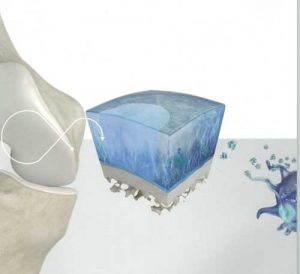Regenerative Cartilage Therapy for Cartilage Defects
Minced Cartilage
Minced Cartilage is an innovative therapy to surgically fill cartilage defects in a joint. In this procedure, autologous cartilage is processed and used in a single minimally invasive operation to fill the defect.
Which joints can be treated?
In principle, cartilage defects in all joints can be treated, provided that the defect is suitable for this procedure.
Studies (see below) show that a cartilage defect, after treatment with the “minced cartilage” technique, integrates and becomes load-bearing again, similar to a cartilage cell transplantation. The procedure can be performed as part of an arthroscopy, i.e., through small 2.5mm skin incisions.
The cartilage defect is cleaned of damaged cartilage parts, creating smooth and sharply defined cartilage edges. The damaged cartilage parts are not discarded but minced and collected in a special filter system. This process is called “mincing” (note: English for “to mince”).
Once sufficient donor cartilage has been harvested, the preparation process begins:
Autologous blood is drawn and specially processed to obtain growth factors on the one hand, and the blood’s “adhesive” on the other, to prepare the cartilage graft. The harvested cartilage chips are mixed with the “blood adhesive” to form a paste, which is then introduced into the cartilage defect and fills it. To give the graft even more stability, it is dabbed with growth factors and blood adhesive and fixed.
What to consider after therapy?
The joint must be completely immobilized for 3 days, after which cautious movement exercises can be started.
In any case, the joint must not be loaded for 6 weeks to ensure optimal healing.
For which cartilage defects is this therapy suitable?
Cartilage defects up to a size of 6 cm². The defect size can be calculated using magnetic resonance imaging.
The affected joint must be stable. Therefore, there should be no untreated ligament tear. This would have to be addressed simultaneously if necessary.
Furthermore, especially in the knee joint, there should be no significant deviation of the load axis (knock-knees, bow-legs). This might need to be corrected simultaneously.
Please contact Dr. Mark Schurz’s practice to discuss your case.
We would be happy to determine if your cartilage defect is suitable for this procedure.
CONTACT
Studies
Studies Orthop J Sports Med. 2019 Jun 13;7(6):2325967119853773.
doi: 10.1177/2325967119853773.eCollection 2019 Jun.
One-Step Autologous Minced Cartilage Procedure for the Treatment of Knee Joint Chondral and Osteochondral Lesions: A Series of 27 Patients With 2-Year Follow-up
Felix Kurt Massen
1
, Cyril Raphael Inauen
1
, Laurent Pascale Harder
1
, Armin Runer
1
, Stefan Preiss
1
, Gian Max Salzmann 1
Knee Surg Sports Traumatol Arthrosc. 2017 Dec;25(12):3824-3833.
doi: 10.1007/s00167-016-4323-7. Epub 2016 Oct 1.
Articular cartilage paste graft for severe osteochondral lesions of the knee: a 10- to 23-year follow-up study
Kevin R Stone 1
2
, Jonathan R Pelsis
3
, Kellen Na 3
4
, Ann W Walgenbach 3
5
, Thomas J Turek 3
J Orthop Res. 2006 Jun;24(6):1261-70.
doi: 10.1002/jor.20135.
Minced cartilage without cell culture serves as an effective intraoperative cell source for cartilage repair
Yiling Lu
1
, Sridevi Dhanaraj, Ziwei Wang, Dino M Bradley, Steven M Bowman, Brian J Cole, Francois Binette
